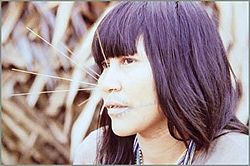- Matsés people
-
Matsés 
Total population approx. 3,200 (various post-2000 est.) Regions with significant populations Matsés Indigenous Reserve: approx. 2,000, Languages Matsés, many also speak Spanish or Portuguese.
Religion Christian, Animist
Related ethnic groups The Matsés or Mayoruna are an indigenous tribe of the Peruvian and Brazilian Amazon. The tribe's ancestral lands are currently threatened by illegal logging practices and poaching. These homelands are located between the Javari and Galvez rivers. The Matsés have guarded their lands from both other indigenous tribes and outsider colonials.
The approximately 3,200 Matsés people speak the Matsés language which belongs to the Panoan language family. In the last thirty years, they have become a largely settled people living mostly in permanent forest settlements. However, they still rely on hunting and gathering for most of their subsistence. Their main source of income comes from selling peccary hides and meat.
The Movement in the Amazon for Tribal Subsistence and Economic Sustainability (MATSES) is an indigenous peoples rights organization that is working for the cultural survival of Matsés People. The founder of MATSES is Dan James Pantone. At present, no outside aid is being provided for the Matsés people by the Peruvian government and many Matsés are dying from preventable diseases such as hepatitis and malaria. The non-profit organization, MATSES, successfully negotiated with the Peruvian government recently to conduct a medical survey of the Matses people under the ASIS (Análisis de Situación de Salud) program; but according to Dr. Pantone, it is difficult for health care providers to reach their indigenous territory due to their isolated location on the Brazilian-Peruvian border.
Contents
Name
The word Matsés comes from the word for 'people' in the Matsés language. They are also known as the "Mayoruna". The name Mayoruna comes from the Quechua (Runa Simi) language and means "river people." In Brazil the Matsés people are generally referred to as Mayorunas, while in Peru they are usually called Matsés.
Technology
The Matses have an elaborate knowledge of the plant and animal life of the surrounding rainforest. Little is imported into the Matsés communities and most of what they need for survival comes from the rainforest. They still use bows and arrows to hunt animals.
Culture
Worldview
In the animist Matsés worldview, there is no distinction between the physical and spiritual worlds and spirits are present throughout the world. The Matsés believe that animal spirits determine health and success in hunting. They are careful not to offend animal spirits and have many taboos for hunting different animal species.
Plants, especially trees, hold a complex and important interest for the Matsés. Each plant is associated with an animal spirit. When a plant product is used as a medicine, it is typically applied externally and the shaman talks to the animal spirit associated with that plant.
Weapons
Bows and Arrows are the main weapons of the Matsés culture, although they are currently rarely used in personal conflict. Generally they are only used for hunting animals. The Matsés were never known to use war clubs as do the neighboring Korubo. Historically, they used blowguns, similar to the Matis tribe of Brazil; however, they recently abandoned blowguns in favor of bows and arrows.
Marriage
Matsés families often practice polygamy. Cross-cousin marriages are most common. Marriages are primarily between cousins, with a man marrying the daughter of his father’s sister (his aunt).
Recent history
The Matsés made their first permanent contact with the outside world in 1969 when they accepted SIL missionaries into their communities. Before that date, they were in effect at warfare with the Peruvian government which had bombed their villages with napalm and sent the Peruvian army to invade their communities. Dan James Pantone and Bjorn Svensson wrote an article about how the Matsés made peaceful contact with the outside world in the Native Planet Journal called "Matsés First Contact: The End of Isolation" [1]. At present, relations between the Matsés people and the Peruvian government are very peaceful.
Indigenous political reorganization
The Matsés are very divided and politically unorganized. Each village has its own chief and there is little centralized authority for the tribe. Lack of political organization has made it difficult for the Matsés people to obtain medical assistance from the outside world.
Land rights
The Matsés have title to the Matsés Indigenous Reserve that was established in 1998. The reserve measures 457000 ha. Despite having title to their own reserve, living conditions for the Matsés have deteriorated. According to a recent article in Cultural Survival Quarterly by Dan James Pantone, living conditions have gotten much worse, to the point that the very survival of the Matsés people is in jeopardy [2]. At present, there is a proposal to expand the Matsés Communal Reserve to give the Matsés people control over their traditional hunting grounds.
References
Romanov S., D.M. Huanan, F.S. Uaqui, and D.W. Fleck. The Traditional Life of the Matsés. CAAAP Press: Lima, Peru. 148 pp.
External links
- The Matses Tribal Organization
 "Mayoruna Indians". Catholic Encyclopedia. New York: Robert Appleton Company. 1913.
"Mayoruna Indians". Catholic Encyclopedia. New York: Robert Appleton Company. 1913.
Ethnic groups in Peru Indigenous AndeanAmazonianAchuar · Aguano · Aguaruna · Amhuaca · Arakmbut · Asháninka · Bora · Canelos-Quichua · Cashibo · Chuncho · Huambisas · Jibitos · Jíbaro · Machiguenga · Matsés (Mayoruna) · Quijos-Quichua · Shipibo-Conibo · Urarina · Yagua · Yanesha' · ZáparaNonindigenous EuropeanOthersCategory:Ethnic groups in Peru Categories:- Indigenous peoples of the Amazon
- Indigenous peoples in Peru
- Indigenous peoples in Brazil
- Uncontacted peoples
Wikimedia Foundation. 2010.
